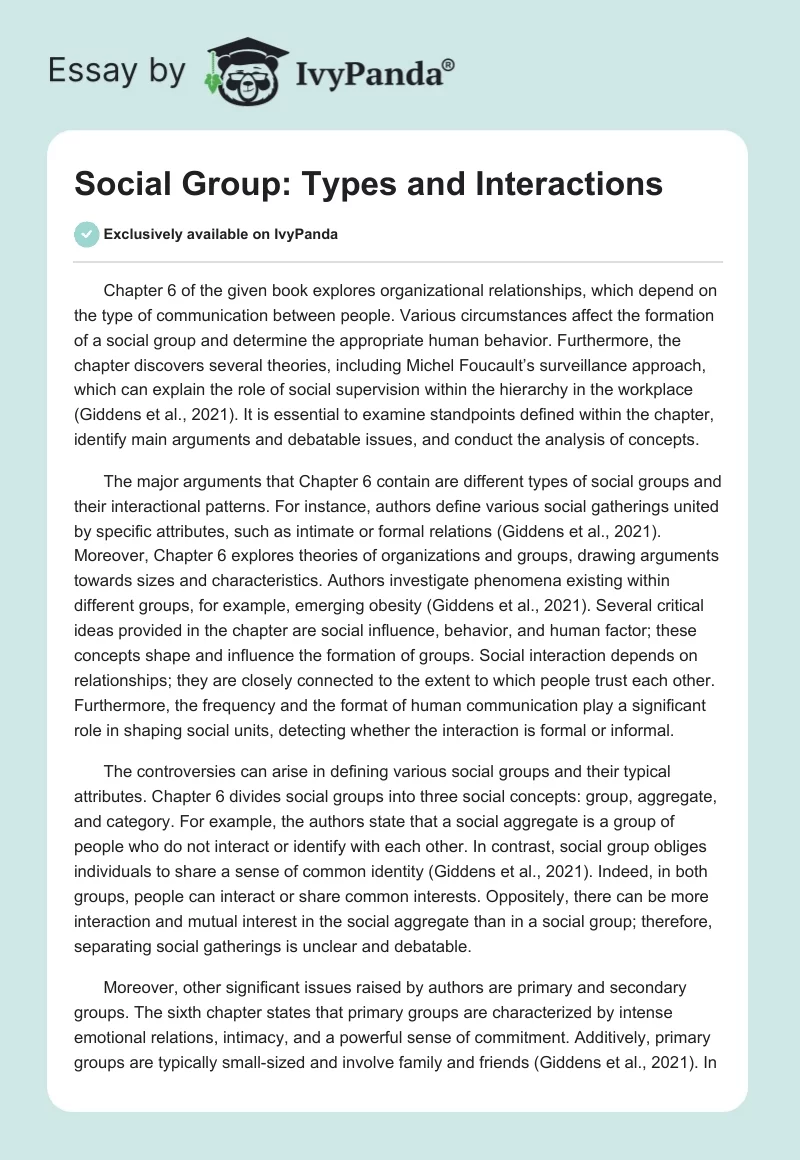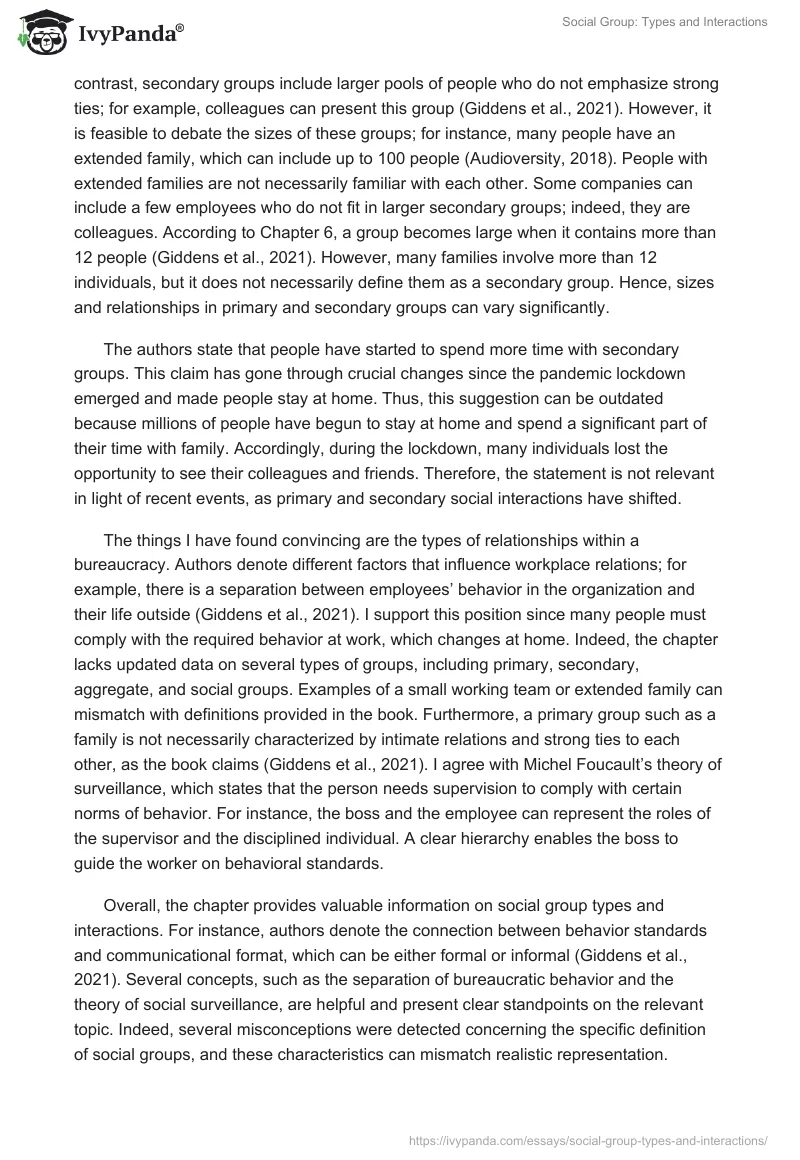Chapter 6 of the given book explores organizational relationships, which depend on the type of communication between people. Various circumstances affect the formation of a social group and determine the appropriate human behavior. Furthermore, the chapter discovers several theories, including Michel Foucault’s surveillance approach, which can explain the role of social supervision within the hierarchy in the workplace (Giddens et al., 2021). It is essential to examine standpoints defined within the chapter, identify main arguments and debatable issues, and conduct the analysis of concepts.
The major arguments that Chapter 6 contain are different types of social groups and their interactional patterns. For instance, authors define various social gatherings united by specific attributes, such as intimate or formal relations (Giddens et al., 2021). Moreover, Chapter 6 explores theories of organizations and groups, drawing arguments towards sizes and characteristics. Authors investigate phenomena existing within different groups, for example, emerging obesity (Giddens et al., 2021). Several critical ideas provided in the chapter are social influence, behavior, and human factor; these concepts shape and influence the formation of groups. Social interaction depends on relationships; they are closely connected to the extent to which people trust each other. Furthermore, the frequency and the format of human communication play a significant role in shaping social units, detecting whether the interaction is formal or informal.
The controversies can arise in defining various social groups and their typical attributes. Chapter 6 divides social groups into three social concepts: group, aggregate, and category. For example, the authors state that a social aggregate is a group of people who do not interact or identify with each other. In contrast, social group obliges individuals to share a sense of common identity (Giddens et al., 2021). Indeed, in both groups, people can interact or share common interests. Oppositely, there can be more interaction and mutual interest in the social aggregate than in a social group; therefore, separating social gatherings is unclear and debatable.
Moreover, other significant issues raised by authors are primary and secondary groups. The sixth chapter states that primary groups are characterized by intense emotional relations, intimacy, and a powerful sense of commitment. Additively, primary groups are typically small-sized and involve family and friends (Giddens et al., 2021). In contrast, secondary groups include larger pools of people who do not emphasize strong ties; for example, colleagues can present this group (Giddens et al., 2021). However, it is feasible to debate the sizes of these groups; for instance, many people have an extended family, which can include up to 100 people (Audioversity, 2018). People with extended families are not necessarily familiar with each other. Some companies can include a few employees who do not fit in larger secondary groups; indeed, they are colleagues. According to Chapter 6, a group becomes large when it contains more than 12 people (Giddens et al., 2021). However, many families involve more than 12 individuals, but it does not necessarily define them as a secondary group. Hence, sizes and relationships in primary and secondary groups can vary significantly.
The authors state that people have started to spend more time with secondary groups. This claim has gone through crucial changes since the pandemic lockdown emerged and made people stay at home. Thus, this suggestion can be outdated because millions of people have begun to stay at home and spend a significant part of their time with family. Accordingly, during the lockdown, many individuals lost the opportunity to see their colleagues and friends. Therefore, the statement is not relevant in light of recent events, as primary and secondary social interactions have shifted.
The things I have found convincing are the types of relationships within a bureaucracy. Authors denote different factors that influence workplace relations; for example, there is a separation between employees’ behavior in the organization and their life outside (Giddens et al., 2021). I support this position since many people must comply with the required behavior at work, which changes at home. Indeed, the chapter lacks updated data on several types of groups, including primary, secondary, aggregate, and social groups. Examples of a small working team or extended family can mismatch with definitions provided in the book. Furthermore, a primary group such as a family is not necessarily characterized by intimate relations and strong ties to each other, as the book claims (Giddens et al., 2021). I agree with Michel Foucault’s theory of surveillance, which states that the person needs supervision to comply with certain norms of behavior. For instance, the boss and the employee can represent the roles of the supervisor and the disciplined individual. A clear hierarchy enables the boss to guide the worker on behavioral standards.
Overall, the chapter provides valuable information on social group types and interactions. For instance, authors denote the connection between behavior standards and communicational format, which can be either formal or informal (Giddens et al., 2021). Several concepts, such as the separation of bureaucratic behavior and the theory of social surveillance, are helpful and present clear standpoints on the relevant topic. Indeed, several misconceptions were detected concerning the specific definition of social groups, and these characteristics can mismatch realistic representation.
References
Audioversity. (2018). What is extended family? Explain extended family, define extended family, meaning of extended family [Video]. YouTube. Web.
Giddens, A., Duneier, M., Appelbaum, R. P., & Carr, D. (2021). Introduction to sociology (Seagull Twelfth). W. W. Norton & Company.


